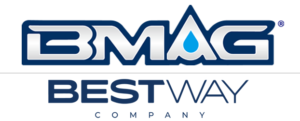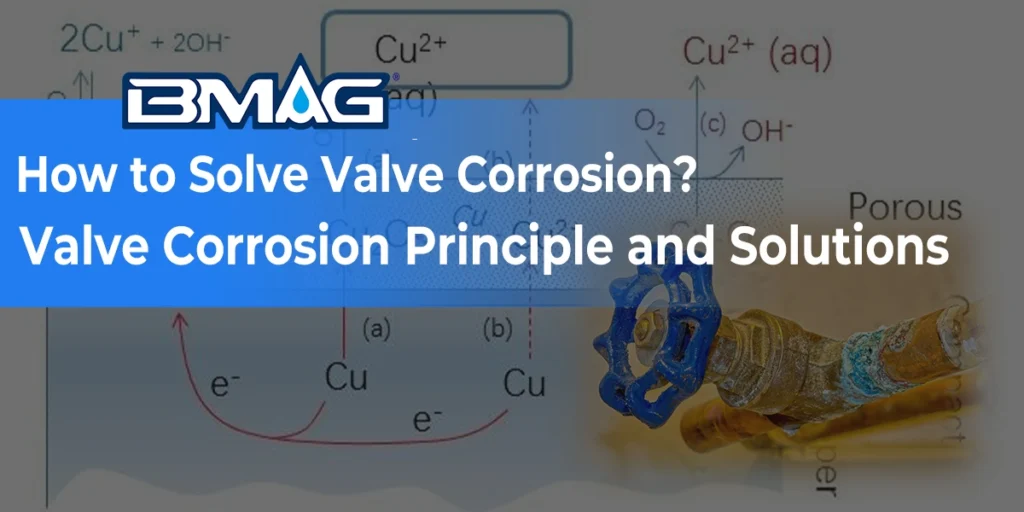According to estimates by experts from the Valve Branch of the China General Machinery Industry Association (CGMA), leakage incidents caused by valve corrosion globally amount to 30,000 annually. The resulting property losses and environmental pollution can exceed 90 million dollars. Valve safety is of paramount importance for the pipe systems. Mar sin, a deep understanding of the causes of valve corrosion and mastering effective valve corrosion protection measures are crucial for the pipe system.
Clàr-innse
Tog suas1. Cause Analysis and Principle Explanation of Valve Corrosion
Valve corrosion is a complex chemical or electrochemical process where valve materials degrade in a specific environment. The primary factors contributing tovalve corrosion include:

- Chemical Nature of the Medium:
- Acidity/Alkalinity (pH): Acidic (e.g., HCl, H₂SO₄) and alkaline (e.g., NaOH) media are highly corrosive to metals.
- Oxidizing/Reducing Properties: Strong oxidizing media (e.g., concentrated nitric acid, chlorine) accelerate metal oxidation.
- Ion Types and Concentration: Ions like chloride (Cl⁻) and sulfide (S²⁻) are common corrosive agents, potentially causing pitting or stress corrosion cracking even at low concentrations.
- Oxygen Content: Dissolved oxygen often acts as a cathodic depolarizer in aqueous solutions, accelerating corrosion.
- Temperature and Pressure: Anns an fharsaingeachd, increased temperature accelerates corrosion reaction rates. Pressure changes can affect media phase and solubility, indirectly impacting corrosion.
- Flow Rate and State: High flow rates can cause erosion-corrosion; solid particles in the fluid exacerbate wear-corrosion; stagnant or turbulent areas can form concentration cells, leading to localized corrosion.
- Properties of Valve Materials:
- Chemical Composition and Microstructure: The inherent corrosion resistance of a material depends on its chemical composition. Mar eisimpleir, chromium (Cr) in stainless steel forms a passive film, enhancing resistance. Grain size, phase composition, and inclusions also affect corrosion behavior. The question of what materials are corrosion resistant is central here.
- Surface Condition: Surface roughness, defects (scratches, cracks), and contaminants influence corrosion initiation and progression.
- Internal Stress: Residual stresses from processing/welding or applied stresses during service can lead to Stress Corrosion Cracking (SCC).
- Environmental Factors:
- External Environment: The external atmosphere (e.g., marine, industrial) can cause corrosion on the valve body’s outer surface.
- Temperature Fluctuations: Cyclical temperature changes can lead to condensation or accelerate the spalling of corrosion products.
- Valve Design and Manufacturing Process:
- Structural Design: Crevices (e.g., flange faces, threaded connections), dead legs, and liquid accumulation areas are prone to crevice corrosion due to oxygen concentration cells or ion enrichment.
- Improper Material Selection: Choosing unsuitable materials for the actual working conditions is a common cause ofvalve corrosion.
- Manufacturing Defects: Welding or casting defects can become corrosion initiation sites.

Brief Introduction to Valve Corrosion Principles:
Metal corrosion is primarily electrochemical. On the metal surface in a corrosive environment, microscopic anodic and cathodic areas form, creating a corrosion cell.
- Anodic Reaction: Metal loses electrons and is oxidized: M → Mⁿ⁺ + ne⁻ (metal dissolution).
- Cathodic Reaction: Oxidizing agents in the environment (e.g., O₂, H⁺) gain electrons at the cathode.
- Oxygen Absorption (neutral/alkaline): O₂ + 2H₂O + 4e⁻ → 4OH⁻
- Hydrogen Evolution (acidic): 2H⁺ + 2e⁻ → H₂↑
Common forms of valve corrosion include uniform corrosion, pitting corrosion, crevice corrosion, galvanic corrosion, intergranular corrosion, Stress Corrosion Cracking (SCC), and erosion-corrosion.
2. Valve Corrosion Solution Strategies for Different Situations
Addressingvalve corrosion requires selecting appropriate solutions based on specific corrosion causes, media characteristics, operating conditions, and cost-effectiveness.
- Rational Material Selection (The Fundamental Solution):
This is the most basic and crucial method for preventing valve corrosion. Understanding what materials are corrosion resistant is key.- Metallic Materials:
- Stainless Steels: Austenitic stainless steels like 304, 316, and 316L are suitable for most weakly corrosive media. For chloride-containing media, duplex stainless steels or higher-alloy stainless steels (e.g., 904L, 254SMO) are preferred.
- Corrosion-Resistant Alloy examples:
- Titanium and Titanium Alloys: Excellent resistance to oxidizing acids (e.g., nitric acid), seawater, and chloride solutions, but not non-oxidizing acids (e.g., HCl, H₂SO₄).
- Cast Iron/Carbon Steel: Low cost but poor corrosion resistance. Often used for less corrosive media like water, smùid, oil, or with anti-corrosion linings.
- Non-Metallic Materials:
- Plastic Valves: PVC, CPVC, PP, PVDF, Ptfe, etc., offer good resistance to many acids, alkalis, and salt solutions but have limitations in temperature, cuideam, and mechanical strength.
- Ceramic Valves: Extremely hard, wear-resistant, and possess excellent chemical corrosion resistance, suitable for highly corrosive and abrasive conditions but are brittle and not impact-resistant.
- Rubber-Lined Valves: Diaphragm valves, butterfly valves, etc., isolate the media from the metal body with a corrosion-resistant rubber lining (e.g., butyl rubber, fluoroelastomer).
- Selection Principle: Thoroughly understand media composition, concentration, temperature, cuideam, flow rate, and impurity content. Consult corrosion data handbooks or conduct corrosion tests to select the most cost-effective material. This leads to the creation of anti corrosion valves designed for specific services. Mar eisimpleir, selecting the right material is crucial for manufacturing a corrosion resistant check valve or corrosion resistant ball valves. Similarly, the integrity of corrosion resistant gate valves agus corrosion resistant stop valves depends heavily on this initial choice.
- Metallic Materials:
- Valve Surface Treatment and Coating Protection (Isolation Protection):
Forming a protective layer on the valve material surface to isolate the metal substrate from the corrosive medium is a key aspect ofvalve corrosion protection.- Non-Metallic Coatings for valve:
- Organic Coatings: Epoxy resin, polyurethane, phenolic resin, fluorocarbon coatings (Ptfe, FEP, PFA). PTFE coatings offer excellent chemical resistance and low friction.
- Inorganic Coatings: Enamel, ceramic coatings. Enamel valves have good acid resistance but are susceptible to impact.
- Metallic Plating/Weld Overlay for valve:
- Electroless Nickel Plating (ENP): Uniform coating, high hardness, good corrosion resistance.
- Hot-Dip Galvanizing: Mainly for external corrosion protection of carbon steel valves.
- Weld Overlay of Corrosion Resistant Alloy: Welding a layer of corrosion resistant alloy (e.g., Stellite, Stàilinn nach meirg) onto critical areas like sealing faces and seats of carbon steel or low-alloy steel valves to enhance local corrosion and wear resistance.
- Lining Technology:
- Rubber Lining, Fluoroplastic Lining (Ptfe, FEP, PFA, PO): Suitable for large-diameter valves or complex internal valve cavities; cost-effective.
- Chemical Conversion Coatings: Phosphating, anodizing, passivation to improve surface corrosion resistance and coating adhesion.
- Non-Metallic Coatings for valve:
- Optimizing Structural Design and Manufacturing Process (Preventing Defects):
- Avoid Crevices and Dead Legs: Ensure smooth flow paths.
- Avoid Dissimilar Metal Contact: If unavoidable, use insulation or select metals with close potentials.
- Eliminate Stress Concentrations: Through proper design and heat treatment to eliminate valve stress.
- Improve Processing Quality: Ensure good weld quality, reduce casting defects, and improve surface finish. This proactive approach helps in producinganti-corrosion valves.
- Regular Inspection and Maintenance:
- Periodic Inspections: Visual checks, thickness measurements, non-destructive testing.
- Timely Replacement: Valves and fittings with severe corrosion should be replaced immediately.

3. Comparison of Valve Corrosion Solution Strategies
| Solution Strategy | Advantages | Disadvantages | Applicability | Cost Consideration |
| Rational Material Choice | Fundamentally solves corrosion, high reliability, long life | Higher initial investment, some special materials difficult to process | Severe corrosive media, critical valves, long service life requirements | High (special materials) |
| Surface Coating/Lining | Relatively lower cost (vs. full alloy), wide applicability | Coating/lining can be damaged/peel, limited life, needs inspection | Medium corrosive media, large valves, higher economic requirements | Medium |
| Media/Process Control | Potentially low cost, can be widely applied | May affect process efficiency, requires precise control, inhibitors may add issues | Controllable corrosion via process, closed-loop systems | Low to Medium |
| Electrochemical Protection | Effective for existing structures, precise control | Needs external power or anode replacement, complex design/maintenance | Buried valves, large submerged valves, specific media (e.g., seawater) | Medium to High |
| Optimized Design/Mfg. | Preventive, reduces risk from source, low marginal cost | Difficult to improve existing valves, needs early consideration | All valve design and manufacturing processes | Low (design stage) |
| Regular Inspect/Maintain | Early problem detection, extends life, avoids sudden failures | Requires resources, potential downtime | All in-service valves | Low to Medium |
4. Conclusion on Valve Corrosion Solutions
Valve corrosion is a complex issue influenced by multiple factors. A singlevalve corrosion solution is often insufficient; a combination of corrosion-resistant methods is better to solve the problem. In practice, a detailed analysis of the valve’s operating conditions and corrosive environment is crucial to identify the primary corrosion types and causes. Based on technical feasibility, economic viability, and safety, choosing the most suitable corrosion resistant materials for valves. This can be supplemented by surface treatments, coatings, and electrochemicalvalve corrosion protection.
From design, material selection, protection to maintenance, a comprehensive valve corrosion prevention plan can minimize or prevent valve corrosion to the greatest extent. Ensuring the safety, stability and long-term operation of corroded valves is of vital importance.








